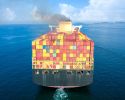What do the 90 percent really mean?

Ninety percent of all international transport takes place at sea — but the largest share of the world’s material trade flows still happens on land. In an article published in the journal Global Sustainability, sustainability researchers call for a more nuanced discussion on how we should address the shipping industry’s impact on the climate.
It’s a familiar claim in climate debates: “90 percent of all goods are transported by sea.” At least, that’s what researchers Christiaan De Beukelaer from the University of Melbourne and Philip Steinberg from Durham University say. But according to their research, the reality is far more complex. They now challenge the figure that has long underpinned both environmental campaigns and political decisions.
“While ships do indeed carry some 80-90 percent of international trade by weight, they only transport a bit over 10% of the global economy’s 100 billion tons of material footprint every year,” said Christiaan De Beukelaer in connection with the article’s publication last week.
This means that while ships transport almost everything in terms of weight, the resource-intensive parts of the economy (such as mining, industry, construction materials, and agriculture) are much larger than the transport sector itself. In short: shipping is “big in weight” but small in environmental impact compared with the production of goods.
According to the researchers, the oft-repeated claim that shipping “accounts for 90 percent of all transport” has led to oversimplified political arguments. Some use it to justify investments in green technology for the maritime sector, while others warn that overly strict regulation could threaten global supply chains. The figure is also used in campaigns promoting more local production and consumption — supposedly to reduce climate impact — but that claim doesn’t hold up.
“Local” production and consumption are, perhaps surprisingly, not necessarily the best way to reduce shipping emissions. Most of what we consume is not actually transported internationally. Most of the resources used are local — or at least domestic, De Beukelaer and Steinberg write.
They further argue that “quantification without context” — that is, using numbers as blunt instruments without critical reflection — can create unintended side effects. It can lead to misplaced focus, with too much attention given to one sector while others are ignored, or to weak regulation being justified (in shipping’s case) because its overall impact seems small despite its size.
Of course, the environmental impact of shipping is far from insignificant. It accounts for about three percent of global greenhouse gas emissions and a significant share of nitrogen and sulfur oxide emissions. De Beukelaer and Steinberg’s point is that the entire value chain — from raw materials and production to consumption and waste — must be included in environmental policy analysis.
“We need to focus on the total environmental impact of trade, not just transport. In this context, it may be more important to consider the emissions and other environmental effects embedded in goods (that is, from the extraction and manufacturing of raw materials) than how far they have been transported. Concentrating production in efficient locations can reduce the overall environmental burden more than producing goods closer to where they are consumed — even if that only slightly reduces the amount of goods transported by sea.”
-
 Ny studie: Eldrivna pendelbåtar kan effektivisera Stockholms kollektivtrafik
Ny studie: Eldrivna pendelbåtar kan effektivisera Stockholms kollektivtrafik -
 EU: Sjöfartens utsläpp ökar
EU: Sjöfartens utsläpp ökar -
 Sociala relationer påverkar val av bränsle
Sociala relationer påverkar val av bränsle -
 Sjöfartens omställning kräver ”mjukare” påtryckningar
Sjöfartens omställning kräver ”mjukare” påtryckningar -
 Hon hade avtalad tid med Kapten ynkrygg
Hon hade avtalad tid med Kapten ynkrygg -
 Lighthouse omvärldsanalys 2025 – osäkerhet och tullar präglar sjöfarten
Lighthouse omvärldsanalys 2025 – osäkerhet och tullar präglar sjöfarten -
 Se seminariet Shipping in the Marine Environment
Se seminariet Shipping in the Marine Environment -
 Vad betyder egentligen de 90 procenten?
Vad betyder egentligen de 90 procenten? -
 Hålla där...
Hålla där... -
 Ny rapport: Klimatförändringarna ett hot mot de flesta större hamnar i världen
Ny rapport: Klimatförändringarna ett hot mot de flesta större hamnar i världen

